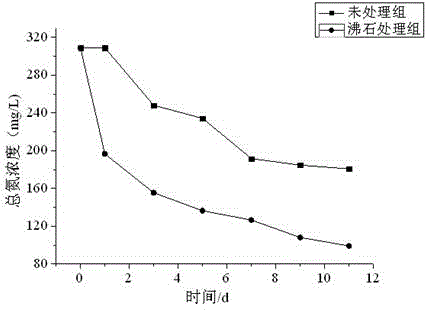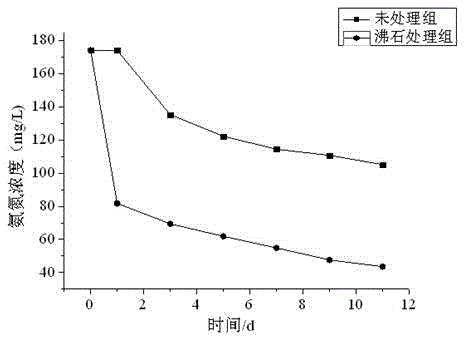Method for treating high-concentration ammonia nitrogen pig breeding biogas slurry
A high-concentration biogas slurry technology, which is applied in the field of pig-raising biogas slurry treatment, can solve the problems of high raw material costs, reduce production costs, reduce environmental treatment costs, and realize the effects of resource utilization of waste
- Summary
- Abstract
- Description
- Claims
- Application Information
AI Technical Summary
Problems solved by technology
Method used
Image
Examples
Embodiment
[0020] Embodiment: implement by following technological process.
[0021] (1) Activation of artificial zeolite: immerse the artificial zeolite in a sodium chloride solution with a concentration of 0.5 mol / L, heat it in a water bath at 100 °C for 2 h, take it out, and dry it to obtain an activated artificial zeolite.
[0022] (2) Pretreatment of biogas slurry: heat-treat pig biogas slurry at 100°C for 20 minutes, and centrifuge at 4800 rpm after cooling. The supernatant is high-concentration ammonia nitrogen pig biogas slurry, with total nitrogen of 308.97 mg / L and ammonia nitrogen of 174.07 mg / L, the total phosphorus is 35.89 mg / L, and the COD is 361.33 mg / L. Take 3 L of this biogas slurry and put it into a 5 L Erlenmeyer flask as the untreated group.
[0023] (3) Zeolite adsorption treatment of high-concentration ammonia-nitrogen pig biogas slurry: take the activated artificial zeolite in step (1) and put it into the high-concentration ammonia nitrogen pig biogas slurry in s...
PUM
 Login to View More
Login to View More Abstract
Description
Claims
Application Information
 Login to View More
Login to View More - R&D
- Intellectual Property
- Life Sciences
- Materials
- Tech Scout
- Unparalleled Data Quality
- Higher Quality Content
- 60% Fewer Hallucinations
Browse by: Latest US Patents, China's latest patents, Technical Efficacy Thesaurus, Application Domain, Technology Topic, Popular Technical Reports.
© 2025 PatSnap. All rights reserved.Legal|Privacy policy|Modern Slavery Act Transparency Statement|Sitemap|About US| Contact US: help@patsnap.com



